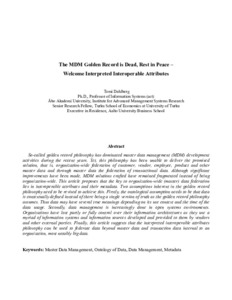The MDM Golden Record is Dead, Rest in Peace – Welcome Interpreted Interoperable Attributes
Tomi Dahlberg
https://urn.fi/URN:NBN:fi-fe2021042716467
Tiivistelmä
So-called golden record philosophy has dominated master data management (MDM) development
activities during the recent years. Yet, this philosophy has been unable to deliver the promised
solution, that is, organization-wide federation of customer, vendor, employee, product and other
master data and through master data the federation of transactional data. Although significant
improvements have been made, MDM solutions crafted have remained fragmented instead of being
organization-wide. This article proposes that the key to organization-wide (master) data federation
lies in interoperable attributes and their metadata. Two assumptions inherent in the golden record
philosophy need to be revised to achieve this. Firstly, the ontological assumption needs to be that data
is contextually defined instead of there being a single version of truth as the golden record philosophy
assumes. Thus data may have several true meanings depending on its use context and the time of the
data usage. Secondly, data management is increasingly done in open systems environments.
Organizations have lost partly or fully control over their information architectures as they use a
myriad of information systems and information sources developed and provided to them by vendors
and other external parties. Finally, this article suggests that the interpreted interoperable attributes
philosophy can be used to federate data beyond master data and transaction data internal to an
organization, most notably big data.
Kokoelmat
- Rinnakkaistallenteet [19207]
